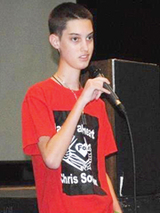Dilated Cardiomyopathy: Chris' Story
Dilated Cardiomyopathy: Chris' Story
Fifteen-year-old Chris Sommer didn’t have any reason to believe something was wrong with his heart. He had no symptoms that would indicate heart trouble, and he was living life like a normal teenager until a routine school physical when his pediatrician found that Chris had a heart murmur and referred him to a cardiologist.
Soon, Chris had a diagnosis of dilated cardiomyopathy — and an appointment with the Heart Failure and Transplant team at CHOP’s Cardiac Center.
CHOP cardiologist Kimberly Lin, MD, was the first to evaluate Chris. She ordered blood tests, an EKG and an echocardiogram, which showed that Chris’ heart function was severely decreased. Chris was admitted to CHOP’s Cardiac Care Unit (CCU) that day and started on a beta blocker, an ACE inhibitor and a diuretic. During Chris’ six-day stay at CHOP, the team also performed additional tests, including an exercise test and a cardiac MRI.
Chris’ medical team closely monitored his condition after he was discharged, and during a follow-up visit about a month later, he was admitted to the CCU again so he could receive more aggressive treatment, including IV medications. But his condition did not improve.
On Nov. 1, 2011, just two months after his initial diagnosis, he was listed for a heart transplant. A week later, he was placed on a left ventricular assist device (VAD), which would keep his failing heart pumping while he waited for a new one.
A multidisciplinary approach
Chris benefited from the unique expertise of CHOP’s Heart Failure and Transplant team, which includes cardiologists, surgeons, physical therapists, nurse practitioners and specially trained intensive care unit nurses.
More About Cardiomyopathy
“We have a large team that works with these patients, who are often very complex and very sick,” says Joseph Rossano, MD, medical director of the Heart Failure and Transplant Program. “Fortunately their outcomes are good, but that’s because there are a lot of people working hard to ensure that they’re good.”
The Heart Failure and Transplant team offers children with heart failure a wide range of treatment options, including medications and, when needed, a ventricular assist device, which acts as a bridge to transplant.
In some cases, children with VADs can return home and resume their normal lives while waiting for a transplant. In other cases, like Chris’, they need to remain in the Hospital, where they can be closely monitored by the Heart Failure and Transplant team.
A new heart

On Jan. 4, Dr. Lin came to Chris’ room and said, “I have some good news.”
“She sat down and said, ‘We think we have a heart for you,’” Chris says. “I was happy about it, but really scared. I told my friends, and they all started crying.”
At 8 o’clock that evening, Chris was taken to an operating room in CHOP’s state-of-the-art Cardiac Operative and Imaging Complex to receive his new heart. The transplant, performed by cardiothoracic surgeon J. William Gaynor, MD, was one of 10 heart transplants done at CHOP in 2012.
Chris spent a month in the Hospital recovering from his transplant. He had frequent physical therapy sessions, both in his room and in the Cardiovascular Exercise Physiology Laboratory, and met with the center’s child life specialists, who have unique expertise in helping transplant patients adjust to life with a new heart.
Chris and his family also participated in the center’s comprehensive education program for transplant recipients and their caregivers. Led by the Heart Failure and Transplant nurse practitioners, the program offers extensive information on everything from avoiding infections to administering the many medications transplant recipients need.
Like many CHOP transplant patients who live more than two hours from the Hospital, Chris spent several weeks at the Philadelphia Gift of Life Family House after he was discharged. His medical team monitored his condition closely with frequent blood tests, echos and heart biopsies, and nurses from CHOP’s Home Care program came to the house regularly to provide follow-up care.
Now, more than a year and a half after his transplant, Chris, now 17, comes to CHOP every three months for follow up and has had no episodes of rejection.
“I’m feeling awesome,” he says.
“I’m back to living my normal life.”